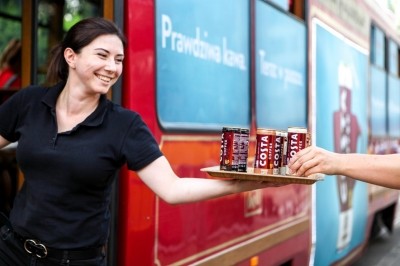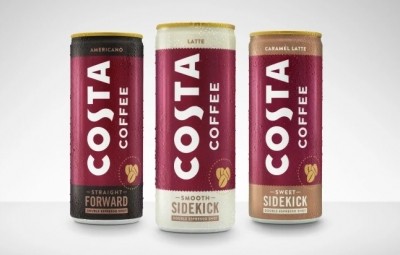An Indian tale of two coffee chains: Starbucks and Cafe Coffee Day

“We are investing for the long-term and see great potential for accelerated growth in India,” he added, as expectant queues of hundreds snaked around the St Thomas Cathedral compound and around Horniman Circle.
BeverageDaily was there to witness those extraordinary massing scenes, which uninformed passers-by might have interpreted as being part of a political rally or Bollywood film set.
There followed similar throngs in other Mumbai locations, and soon New Delhi. Within six months, there were 10 stores, each one wildly busy.
An international take on coffee
It was easy to understand why. Up to this point, homegrown Cafe Coffee Day had dominated the coffee scene since its arrival in the Nineties, with outlets concentrated in a way that echoed how Starbucks had evolved in America: there was never a store very far off.
But bright and pleasant the CCD outlets might have been, and eclectic as the menus were, they offered a distinctly Indian take on the coffee shop. Coffee lovers, and latte drinkers in particular, had been craving an alternative that focused solely on their favourite brew, presented in an international way. A glimpse of Seattle coffee culture had arrived in aspirational India.
This month Starbucks entered the lucrative Gujarat market with five new stores, bringing the total to 157 outlets in 10 cities. It is on track this year to easily eclipse the 30 stores it opened in 2018. The queues of 2012 might not snake outside the way they did, but there remains a deep affection for the brand among well-heeled Indians.
According to Navin Gurnaney, chief executive of Tata Starbucks, the company formed under a joint-venture with local conglomerate Tata Group, it is poised to break even in seven months as India’s coffee culture continues to attract more increasingly free-spending members of the middle-class.
The new Gujarat stores, in wealthy Ahmedabad and Surat, India’s diamond cutting capital, represent the first time Starbucks has opened five in a state in one go. The state is also dry, with liquor prohibition in place, so it is not hard to see how “Gujarat is an important market for us,” as Gurnaney put it.
With some 270,000 customers per week, Tata Starbucks reported turnover of INR4.4bn (US$62.3m) for the 2018-19 fiscal year.
“The coffee culture is being spearheaded by millennials, the upwardly mobile and people who travel and understand brands,” the chief executive said at the Ahmedabad openings.
“Two years ago, we set up 25 stores. During last fiscal we added 30 stores. This year we will beat that number substantially, and by end of March 2020, we will have added many more stores than we added in the past," Gurnaney added.
India: one of the fastest growing coffee markets
India is one of the top-five fastest growing markets for Starbucks in the world. It typically invests INR15m-20m (US$211,000-282,000) in opening a new Indian outlet.
In its last annual report, Tata Global Beverages said its Starbucks joint-venture posted a top-line growth of 30%, which it put down to growth in store sales and an expansion of outlets.
As of 2018, the country’s coffee and tea chains brought in INR25.7bn (US$362m), according to Euromonitor. It is now the world’s tenth fastest growing market for specialist retailers, while coffee alone is one of the fastest growing categories in India’s consumer food service industry. The market researcher expects tea and coffee retailers to increase sales at 6.9% a year to INR45.4bn (US$640m) by 2023.
CCD seems to have benefited from increased competition — at least from the customer’s point of view — with the arrival of international brands The Coffee Bean and Tea Leaf, Costa and Gloria Jeans, as well as a plethora of local chains. But it has struggled on a corporate level.
It started off as a single cafe in Bangalore in 1996 and was the first to cash in on a more outward-looking India at the time, following economic liberalisation policies implemented in the decade before the turn of the century. It offered middle-class Indians a place to hang out over inexpensive drinks.
The company didn’t only focus on metropolitan cities like Mumbai and Delhi, but also blazed a path through second- and third-tier centres. Likewise, it expanded into suburban areas, where rents for its small stores are much cheaper.
Despite its first-mover advantage, the arrival of international brands and upmarket local chains has forced CCD to raise its game in a crowded market. As competition in India’s coffee chain market has gained pace over the last few years, same-store sales growth at CCD fell from 8.2% to 5.4% in the year to March 31. The chain also expanded at a relatively modest pace, though it was closing in on 1,800 outlets in 243 cities at the time.
Analysts have been starting to mutter about the imminent acquisition of the Indian chain, especially after the recent death of its influential founder, VG Siddhartha. Coca-Cola, which recently bought Britain’s Costa, is reportedly in the race to snare CCD, though this is yet to be confirmed.
Fifty-nine-year-old Siddhartha’s remains were recovered from the Nethravathi river near Mangaluru following his apparent suicide at the end of last month. A letter purportedly written and signed by Siddhartha and sent to senior CCD management laid out his struggles with a “serious liquidity crunch” that in turn had led to "tremendous pressure" from lenders and an unnamed private-equity investor.
Tata Starbucks also has been tipped as a possible suitor for the indigenous chain, though its chief executive has refused to entertain speculation of acquisitions, saying only his brand would be “thoughtfully aggressive” in its plans for expansion.
“[At present] we are not in conversations with anybody for acquisition, but we are looking to grow all the time," Gurnaney added.
There is a feeling now that the global coffee chain brands might leave behind those who try to compete too closely with them. Though they don’t have the store numbers of Indian brands, they do have the immediate recognition and reflect the wistful image Indians increasingly have of international coffee culture. Now they are established, they will be very difficult to beat.








